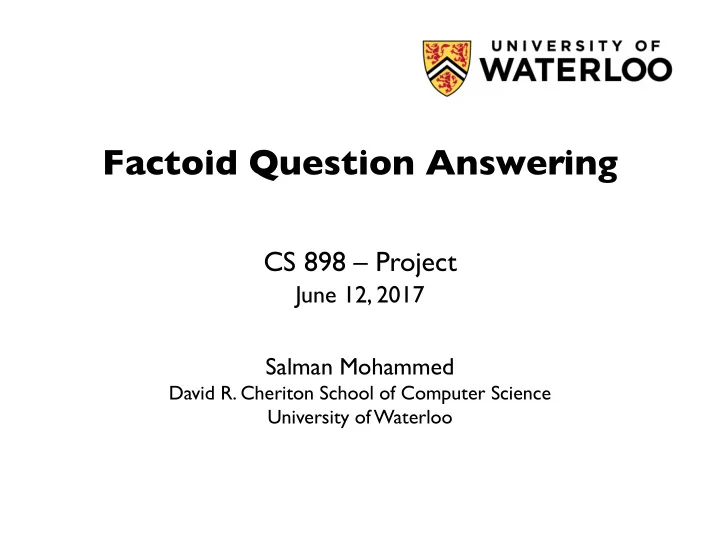

Factoid Question Answering CS 898 – Project June 12, 2017 Salman Mohammed David R. Cheriton School of Computer Science University of Waterloo
Motivation Source: Wikipedia (Factory) Source: https://www.apple.com/newsroom/2017/01/hey-siri-whos-going-to-win-the-super-bowl/
Source: Google
Examples Q: Who is the Falcons quarterback in 2012? A: Matt Ryan Q: Where did George Harrison live before he died? A: Liverpool Q: Who were the parents of Queen Elizabeth I? A: Anne Boleyn, Henry VIII of England
Task simple factoid question answering answers reference a single fact in the knowledge-base Freebase – large knowledge base 17.8M million facts, 4M unique entities, 7523 relation types fact: Bahamas country/currency Bahamian_dollar different from complex questions Q: Who does David James play for in 2011? Q: What year did Messi and Henry play together in Barcelona?
Not that simple…
Approach Q: Who were the parents of Queen Elizabeth I? A: Anne Boleyn, Henry VIII of England Entity: Queen Elizabeth I Freebase Entity MID: m.02rg_ Relation: /people/person/parents Lookup Freebase: query (entityid, relation)
Difficulties no consistent way to do entity name à ID conversion ‘JFK’ could refer to a person, president, film, airport. evaluate correct answer ‘Cuban Convertible Peso’ vs. ‘Cuban Peso’ state-of-the-art accuracy: ~76% many facts long pipeline
Assuming you know… Word Vectors dense vector representation for words word2vec, GloVe Fully Connected Neural Networks every node in a layer connected to all nodes in the previous layer fixed size input(image) and output(classes) Recurrent Neural Networks modelling sequences reasoning about previous events to make decision
Recurrent NNs Input: x t word embedding Memory/State: h t embedding based on current input and previous state final state: think “sentence embedding”
Deep Bi-directional RNNs Source: http://www.wildml.com/2015/09/recurrent-neural-networks-tutorial-part-1-introduction-to-rnns/
Problem with RNNs Learning long-term dependencies “I grew up in France … I speak fluent ____.” Vanishing/Exploding gradient problem notice that the same weight matrix is multiplied at each time step during forward and backward propagation
Long Short Term Memory Networks (LSTMs) Avoid long term dependency problem remember information for a long time Idea: gated cells complex node with gates controlling what information is passed through maintains an additional “cell state” - c t Source: http://introtodeeplearning.com/Sequence%20Modeling.pdf
Method Source: Google Source: Google
Approach Q: Who were the parents of Queen Elizabeth I? A: Anne Boleyn, Henry VIII of England Entity: Queen Elizabeth I Freebase Entity MID: m.02rg_ Relation: /people/person/parents Lookup Freebase: query (entityid, relation)
Entity Detection NO NO YES NOTE: followed by fully connected layers Who is Einstein
Entity Linking ‘Einstein’ à ‘ m.013tyr’ more than one entity refers to ‘Einstein’ build a Lucene index of all entities store entity MID as docid store the name variants in different fields ranked retrieval – BM25
Relation Prediction people/person/birth_place NOTE: followed by fully connected layers Einstein Where was born
Relation Prediction • Dataset: Simple Questions • Training set: ~76,000 examples • Validation set: ~11,000 examples • Number of classes: 1,837 relation types • Model: Bi-directional LSTM (4 layers) • Accuracy on validation set: ~81%
Other Ideas joint-model the (entity, relation) pair rank entities, relations and then, joint-model them convolutional networks with attention modules character level CNN for entity detection word level CNN for relation prediction
Practical Tips Source: Google
Tricks of the Trade Activation function: try ReLU prevents from shrinking gradients Optimization algorithm: try Adam computes adaptive learning rate; usually faster convergence read: http://sebastianruder.com/optimizing-gradient-descent/index.html Weight initialization: use Xavier initialization make sure weights start out ‘just right’ Prevent overfitting: dropout, L2 regularization dropout prevents feature co-adaptation remember to scale model weights at test time for droput
Tricks of the Trade (cont’d) Random Hyperparameter Search grid search is a bad idea; read: https://arxiv.org/abs/1206.5533 some hyper-parameters more important than others Batch Normalization make activations unit gaussian distribution at the beginning of the training insert BatchNorm layer immediately after fully-connected/convolutional layers Initialize recurrent weight matrix, W hx & W hh , to identity matrix helps vanishing gradient problem. read: https://arxiv.org/pdf/1504.00941.pdf Gradient clipping helps exploding gradient problem
Acknowledgement Wengpen Yin et al. https://arxiv.org/abs/1606.03391 Ferhan Ture, Oliver Jojic https://arxiv.org/abs/1606.05029 Christopher Olah http://colah.github.io/posts/2015-08-Understanding-LSTMs/ Jimmy Lin slide template taken from https://lintool.github.io/bigdata-2017w
Questions? Source: Google
Recommend
More recommend